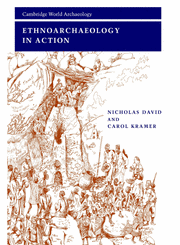Book contents
- Frontmatter
- Dedication
- Contents
- List of figures and credits
- List of tables
- Preface
- Acknowledgments
- Map
- 1 Ethnoarchaeology: its nature, origins, and history
- 2 Theorizing ethnoarchaeology and analogy
- 3 Fieldwork and ethics
- 4 Human residues: entering the archaeological context
- 5 Fauna and subsistence
- 6 Studying artifacts: functions, operating sequences, taxonomy
- 7 Style and the marking of boundaries: contrasting regional studies
- 8 Settlement: systems and patterns
- 9 Site structures and activities
- 10 Architecture
- 11 Specialist craft production and apprenticeship
- 12 Trade and exchange
- 13 Mortuary practices, status, ideology, and systems of thought
- 14 Conclusions: ethnoarchaeology in context
- Bibliography
- Index
2 - Theorizing ethnoarchaeology and analogy
Published online by Cambridge University Press: 05 March 2015
- Frontmatter
- Dedication
- Contents
- List of figures and credits
- List of tables
- Preface
- Acknowledgments
- Map
- 1 Ethnoarchaeology: its nature, origins, and history
- 2 Theorizing ethnoarchaeology and analogy
- 3 Fieldwork and ethics
- 4 Human residues: entering the archaeological context
- 5 Fauna and subsistence
- 6 Studying artifacts: functions, operating sequences, taxonomy
- 7 Style and the marking of boundaries: contrasting regional studies
- 8 Settlement: systems and patterns
- 9 Site structures and activities
- 10 Architecture
- 11 Specialist craft production and apprenticeship
- 12 Trade and exchange
- 13 Mortuary practices, status, ideology, and systems of thought
- 14 Conclusions: ethnoarchaeology in context
- Bibliography
- Index
Summary
It is particularly because human beings delegate to artifacts, to exchange and to technical acts a large part of the construction and the conservation of their social ties that human societies constitute stable frameworks, in contradistinction to the societies of other primates that – transient because they lack things – require to be continuously (re)constructed by direct contacts (touches, looks, sounds, smells), and by the physical closeness and continuous active involvement of the participants.
(Anick Coudart 1992a: 262, our translation).What recourse is there for the imaginatively challenged?
(Bruce Trigger 1998: 30)The vast majority of publications on ethnoarchaeology take no explicit theoretical position – which does not mean that they are atheoretical. In this chapter we offer the reader a basic toolkit with which to examine the theory, implicit or explicit, expressed in the ethnoarchaeological literature that we will be considering in the course of this book. For two reasons the toolkit we offer at this stage is a minimal one. First, most of us prefer to deal with theoretical complexities as they arise and in a factual context. Second, this is not the place to attempt to survey the wide web of theoretical positions taken by archaeologists (and to a lesser extent ethnoarchaeologists) following an influx of theory reaching anthropology in the 1970s and 1980s from a variety of sources including the philosophy of science, literary theory, and sociology.
- Type
- Chapter
- Information
- Ethnoarchaeology in Action , pp. 33 - 62Publisher: Cambridge University PressPrint publication year: 2001



